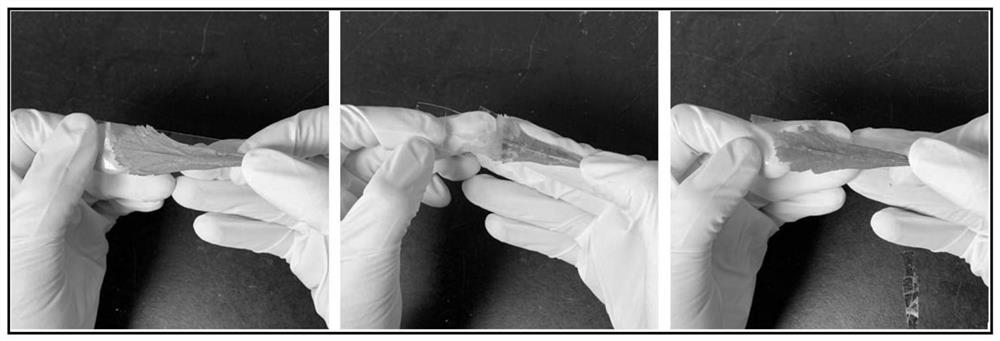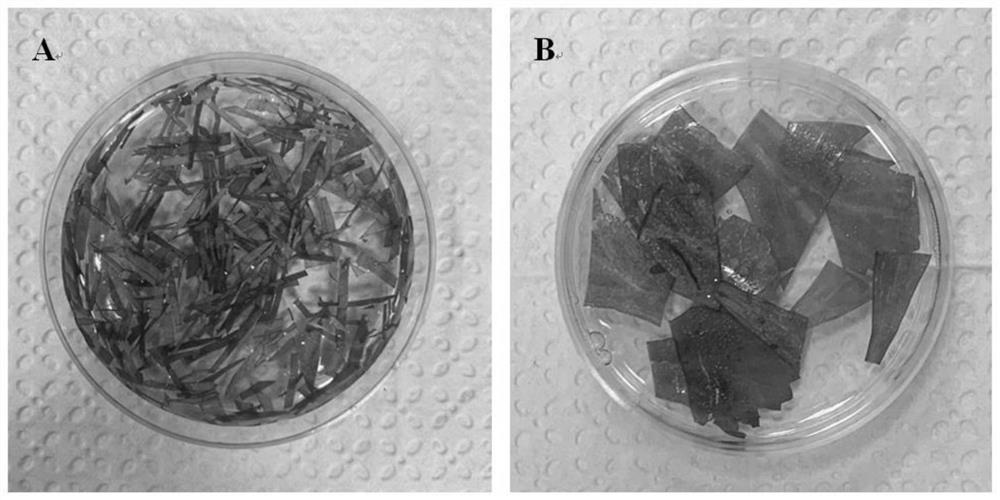Artemisia japonica mesophyll protoplast separation and conversion method
A technology for protoplasts and Artemisia annua is applied in the field of separation and instantaneous transformation of Artemisia mesophyll protoplasts, which can solve the problems of accelerating the research and development process of biosynthesis of natural active ingredients, and achieve the effect of good state and high yield.
- Summary
- Abstract
- Description
- Claims
- Application Information
AI Technical Summary
Problems solved by technology
Method used
Image
Examples
Embodiment 1
[0037] This embodiment relates to a method for isolating protoplasts of Artemisia annua, comprising the following steps:
[0038] Preparation of protoplasts from leaves of Artemisia annua;
[0039] (1) Select Artemisia annua cuttage seedlings that have grown robustly in 3-4 weeks. At this time, each plant seedling has 8-10 young leaves, and the lower epidermis of the leaves is torn off with adhesive tape, such as figure 1 shown;
[0040] (2) Preplasma separation: soak the leaves with the lower epidermis removed in 0.4mol / L mannitol solution for 1 hour;
[0041] (3) Enzymolysis: Put the leaves soaked in the mannitol solution into the enzymolysis solution, about 5-10 leaves. Vacuum for 30 minutes in the dark, and put into a horizontal shaker for dark enzymatic hydrolysis for 4 hours. The enzymatic hydrolysis solution is 1.75% cellulase R10, 0.5% dissociated enzyme R10, 0.4mol / L mannitol, 0.02mol / L potassium chloride, 0.02mol / L MES (pH=5.7) and placed in a 55°C water bath Aft...
Embodiment 2
[0051] For the treatment of the young leaves of Artemisia annua in the method of Example 1, the present invention provides two processing methods: cutting the leaves of Artemisia annua into thin strips and putting them into the enzymatic hydrolysis solution, tearing off the lower epidermis of the leaves with adhesive tape and putting them into the enzymatic hydrolysis solution, The treated young leaves were subjected to enzymolysis and purification according to the method in Example 1. The results showed that the lower epidermis of the young leaves should be torn off with adhesive tape (Table 1).
[0052] Table 1 Cutting into 5mm thin strips and tearing off the lower epidermis of leaves with adhesive tape, protoplast yield and vitality
[0053]
[0054]
[0055] Such as figure 2 , the young leaves were cut into 5mm thin strips and the lower epidermis of the leaves were torn off with adhesive tape, and the yield and vitality of the protoplasts obtained by cutting the le...
Embodiment 3
[0057] For the preplasma separation in the method of Example 1, the present invention sets a control group without preplasma separation in the process of preplasma separation, and the specific results are shown in Table 2.
[0058] Table 2 Effect of preplasma separation on protoplast yield and vigor
[0059]
[0060] As shown in Table 2, pretreatment with 0.4 mol / L mannitol for 1 h on the leaves without the lower epidermis significantly increased the yield of protoplasts, and the activity of protoplasts increased to 80.0%.
PUM
 Login to View More
Login to View More Abstract
Description
Claims
Application Information
 Login to View More
Login to View More - R&D
- Intellectual Property
- Life Sciences
- Materials
- Tech Scout
- Unparalleled Data Quality
- Higher Quality Content
- 60% Fewer Hallucinations
Browse by: Latest US Patents, China's latest patents, Technical Efficacy Thesaurus, Application Domain, Technology Topic, Popular Technical Reports.
© 2025 PatSnap. All rights reserved.Legal|Privacy policy|Modern Slavery Act Transparency Statement|Sitemap|About US| Contact US: help@patsnap.com



